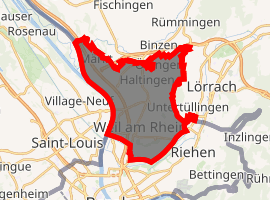Weil am Rhein
Weil am Rhein (High Alemannic: Wiil am Rhii) is a German town and commune. It is on the east bank of the River Rhine, and extends to the point at which the Swiss, French and German borders meet. It is the most southwesterly town in Germany and a suburb of the Swiss city Basel. Weil am Rhein is part of the "trinationale Agglomeration Basel" with about 830,000 inhabitants.
Weil am Rhein, Germany | |
|---|---|
Townhall and market place of Weil am Rhein | |
 Coat of arms | |
Location of Weil am Rhein, Germany 
| |
 Weil am Rhein, Germany  Weil am Rhein, Germany | |
| Coordinates: 47°35′41″N 7°36′39″E | |
| Country | Germany |
| State | Baden-Württemberg |
| Admin. region | Freiburg |
| District | Lörrach |
| Subdivisions | 7 |
| Government | |
| • Mayor | Wolfgang Dietz (CDU) |
| Area | |
| • Total | 19.47 km2 (7.52 sq mi) |
| Elevation | 281 m (922 ft) |
| Population (2018-12-31)[1] | |
| • Total | 30,175 |
| • Density | 1,500/km2 (4,000/sq mi) |
| Time zone | CET/CEST (UTC+1/+2) |
| Postal codes | 79546–79576 |
| Dialling codes | 07621 |
| Vehicle registration | LÖ |
| Website | www.weil-am-rhein.de |
Geography
Weil am Rhein is located at 47°35′42″N 7°36′39.6″E in the district of Lörrach in the Federal State of Baden-Württemberg. The city limits border France to the west and Switzerland to the south including the triple border of the three countries. Locally, Weil is situated in the region referred to as Markgräflerland.
The city's location on the Rhine and proximity to the Black Forest give it a continental climate, particularly suited to viticulture.
History
The town is first documented in the year 786 as Willa, a name which is thought to be of Roman origin. The duc de Villars crossed the Rhine here in October 1702 to fight the Battle of Friedlingen during the War of the Spanish Succession. Weil was severely damaged as a result of the conflict.
Agriculture dominated local industry until the 19th century, when the city began to grow, aided by its favourable transport connections. A railway marshalling yard linking Weil am Rhein to Basel was built in 1913. Swiss textile factories were established in the Friedlingen quarter. 1934 saw the construction of a harbour on the Rhine.
After the Second World War the population again grew rapidly due to the influx of refugees and stateless persons. Between 1971 and 1975 the communities of Ötlingen, Haltingen and Märkt were incorporated and Weil am Rhein became a substantial town.
Since 2014, line 8 of the Basel tram system has extended across the border from Switzerland to terminate in Weil am Rhein.
Mergers
The former municipalities were merged into Weil am Rhein:
- Coat of arms of the former municipalities
 Haltingen
Haltingen Märkt
Märkt Ötlingen
Ötlingen
International relations
Weil am Rhein is twinned with:



Tourism and leisure
- The premises of the furniture maker Vitra, featuring buildings by architects such as Frank Gehry, Zaha Hadid and Tadao Ando, are an attraction for architecture fans. The premises also include the Vitra Design Museum.
- The Laguna water park
- Landesgartenschau Baden-Württemberg 1999, "Grün 99"[5]
Personalities
Sons and daughters of the city
- Enjott Schneider (actually Norbert Jürgen Schneider ; born 1950), composer and writer
- Patrik Köbele (born 1962), politician, President of the German Communist Party (DKP)
- Christian Streich (born 1965), former German Bundesliga footballer and current head coach at SC Freiburg
People who are connected to Weil am Rhein
- Hubert Schardin (1902-1965), physicist, who lived in Weil
- Martin Beneke (born 1966), physicist, completed his schooling at the Kant-Gymnasium. Beneke was awarded the Gottfried Wilhelm Leibniz Prize in 2007 for his researches in the field of theoretical elementary particle physics.
- Former Lynyrd Skynyrd drummer Artimus Pyle traces his ancestry to Weil am Rhein through Claus Koger (1572-1630)
References
- "Bevölkerung nach Nationalität und Geschlecht am 31. Dezember 2018". Statistisches Landesamt Baden-Württemberg (in German). July 2019.
- Portrait of Ötlingen (in German). Retrieved 30 June 2014.
- Portrait of Haltingen (in German). Retrieved 30 June 2014.
- Portrait of Märkt (in German). Retrieved 30 June 2014.
- 1999 Landesgartenschau Weil am Rhein Archived 8 April 2015 at the Wayback Machine (in German). Retrieved 30 June 2014.
External links
- Official site (in German)
- Vitra Design Museum (in German and English)
- Laguna water park (in German)
- Weil am Rhein: pictures (in German)